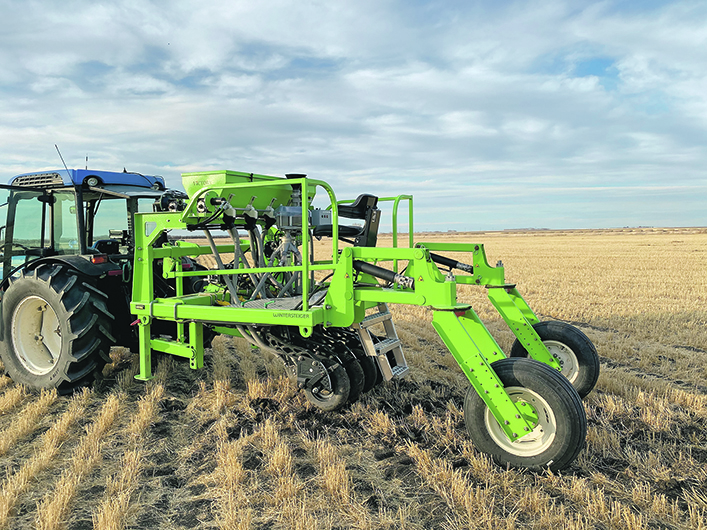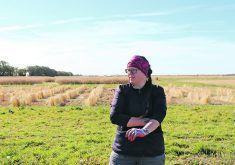Better varieties of pulse, cereal, forage and oilseed crops depend on accurate research data collected at carefully monitored research and field-size plots. The Western Grains Research Foundation supports nine such prairie sites.
Localized agronomic research, managed by farmer-driven research organizations, fosters varieties and labels appropriate to each region. Knowing that a certain crop or agronomic recommendation is based on conditions close to his own operation is a tremendous benefit according to Doug Martin. Martin farms at East Selkirk, Man., and is a WGRF director.
“There’s a reason that universities, multinationals, producer groups, federal and provincial organizations are doing more local research,” said Martin in a phone interview.
Martin points out that programs like Nexera’s canola heat blast insurance are only possible because of localized information pertaining to soil and variety, and more importantly to documented weather patterns typical for that locale. If Nexera has confidence in localized data, it allows them to offer heat blast insurance.
The same type of finely tuned crop response data that pertains to a certain area is also crucial to crop breeders who are able determine which strains are appropriate to Yorkton, Sask., but not appropriate to Gimli, Man., for example. This detailed information forms the basis for new varieties and more precise management of fertility and crop protection. Data collected at the nine WGRF stations is merged with on-farm data collected by nearly every farm on the Prairies.
“We have all kinds of platforms like Climate Field View that lets us track weather and conditions related to yield. Whether it’s traditional research stations or on-farm platforms, it’s all part of localizing agronomic research. WGRF research farms are vital to providing localized data.”
Farmers have known for a century that improved crop varieties require sound agronomic research and good data. But farmers also know that when a 40-year-old plot combine continually breaks down and catches fire, the harvest data required by researchers may be somewhat tainted. It’s obviously time to replace that firetrap.
That’s the squeeze many prairie research institutions found themselves in. Realizing the depth of the problem, WGRF stepped last year with grants to buy equipment, particularly research plot seeders and modern plot combines.
“It’s tough to conduct research when your plot combine has a tendency to catch fire,” says Ken Coles, executive director at the Farming Smarter project in Lethbridge.
Farmers sometimes scoff at research reports, saying the data isn’t representative of real fields. Coles answer to that was to buy a plot combine that’s big enough and quick enough to harvest crops in any farmer’s field and document the results. For example, if a farmer is testing a new nutrient regime in a whole field, Coles and his crew can measure the impact.
“The challenge of collecting data in a farmer’s field is that farmers are in the business of farming, not research,” says Coles in a phone interview. “The new Wintersteiger combine allows the team to take a single pass through the different treatments, and then make comparisons to the farmers yield monitor, plus comparisons to the old-fashioned weigh wagons.”
Coles says research yield monitors are more accurate and reliable than commercial monitors on field-scale combines. Commercial yield monitors use a pressure plate to measure yield. Monitors on the $253,000 research combine weigh each sample and conduct on-board protein analysis.
Automation is the other big upgrade that makes Wintersteiger data collection more efficient. It automatically raises the table, does cleanout and then cycles properly so you can move on to the next plot. Automation allows on-site humans to make better use of their time.
“The machine has a lot of electronics, so you need an operator who can deal with that. It’s not without its problems, just like any machine,” Coles said. “But it is a bigger, beefier machine and it’s got a reverse. With the old plot machine, if we got a plug we had to stop and clear it out by hand. That wasted a lot of time. Now we simply reverse the system and it clears itself.
“That means we can get into heavier crops to collect data. That’s new for researchers. We often get into well-manicured crops that have a huge yield and a huge amount of biomass, especially on our irrigated crops.”
Cole said the Farming Smarter plots test virtually anything that has to do with crop production, including variety development, nutrient management, rotations to break disease cycles and other crop protection methods.
Such projects require yield data at the end of the growing season. Changing concaves and sieves allows the team to collect data from every crop that might be grown in Alberta.
“One of the significant features of this combine is that it handles hemp. Hemp is always a tough crop to combine, so that means it’s hard to gather good comparative yield data.
“We still don’t have the equipment to geo-reference the data. So far there hasn’t been much demand for that in a small plot combine. But we have trials out on farm fields all over, and we’ll need to start geo-referencing the data we collect. RTK will be our next major upgrade. That’s probably $20,000.”
The Wintersteiger Flex plot seeder is based on the design that was engineered by the Farming Smarter team. It has a removeable tool bar that can be changed for different seeding trials.
“We had an old plot seeder that we really liked. It had a lot of flexibility. The technology dated back to the old PAMI days. We took that old design and worked it into this newer version in conjunction with the Ag Tech centre. We wanted this same design, but we needed more monitoring technology so we could do a whole range of seeding scenarios.
He said Wintersteiger took the design and gave it a monitor, a metering system and electric controls to lift the openers without lifting the whole machine.
Indian Head Agricultural Research Foundation, IHARF, had a big need for equipment to improve their research activities, according to executive manager Danny Petty.
The list of items funded by WGRF included a weigh wagon, drones, weather stations, a Valmar applicator, a mower, sample processing equipment, sample drying shed, a tractor and the Wintersteiger plot combine.
“The combine dramatically speeds up our harvest operations. With the old system we had to manually bag the entire sample. Then we had to clean them and determine dockage and protein, then calculate yield according to total weight of each bag,” said Petty.
“The new plot combine has a Harvest Master system that gives exact yield as we go through a plot. We don’t have to wait for the entire sample to come through the combine. We can collect a sub-sample and then carry on with the work. There’s less sample material to handle and faster results. We no longer need to harvest the entire plot.”
Petty says another benefit of the quicker harvest is they can now conduct their harvest for each plot at the optimal time for that crop. Previously they missed that critical window because the machine was busy at a different plot or field.
“There’s one other thing that’s a really big deal for our operators. This combine has a cab. That’s appreciated when you start harvest in August and it’s 35 C, or you’re still combining in November when it’s -5 C. Out of the weather. Out of the dust. Just like a real combine now. WGRF paid for it, $387,000 dollars. That’s about the same as what a real combine used to cost.

“That’s a lot of money, but we do quite a bit of pulse research. Those are high-value crops, so it’s well worth the investment. We’re looking at rotational options for novel pulse crops, fertility trials for peas and lentils. There’s a number of soybean projects we’re working on. We’re working on cover crops with pulses. New and novel fertilizers. This year we’ll end up with about 50 small plot trials.”
Wintersteiger
Cory Pearson manages the Wintersteiger plant in Saskatoon, where they design and fabricate small-scale farm equipment such as plot seeders and combines.
“Our technology lets a researcher design plot layout and instruction from their office desktop and transfer those prescriptions to the field, using the same software to plant and harvest plots,” Pearson said in an email interview.
“Plot and field-scale research has shown that accuracy and consistency pay in bringing product to market quicker, either improved varieties or agronomic recommendations. New technology removes human error and inconsistencies. Software solutions yield a higher degree of accuracy and repeatability.
“Some of our customers who received the WGRF grant are doing a wide variety of seed trials that need custom solutions to meet the requests from industry.”
He says there is a range of options, such as planting different plot lengths and populations without stopping. The benefit of quick seeding is that all seeds can be placed in the soil in a timely manner, according to recommendations. Metering units can be either electric or hydraulic. There are many on-the-go without-stopping options:
- plant spacing
- small or large seeds
- liquid fertilizer
- GPS integration
- blend fertilizer with multiple product boxes
- adjust seed and fertilizer rates
- adjust plot length from plot to plot
- wide variety of zero-till modern openers.
- adjust hydraulic down pressure
- independent control of multiple ranks
“Our unique frames allow the move to heavier no-till planters, often without requiring a larger tractor.”
Western Grains Research Foundation
WGRF has earmarked $53 million for research funding over the next four years. The recent equipment grants not only fund specific projects, but also provides tools and talent to support a strong research community across the prairie provinces.
“Adding key capital items to the inventory of research tools is critical to expanding crop production research program in terms of size, scope and quality,” said WGRF executive director Garth Patterson.
WGRF has committed $32 million to an initiative, starting with talent. It supports research chairs at the universities of Alberta, Saskatchewan and Manitoba. An existing program provides scholarships for graduate students to help fund their training and associated research work. The second ongoing phase started in 2019 includes new equipment and other assets to provide up-to-date tools.
While wheat and barley were once the main WGRF focus, the group now funds work on 15 different crops. With more than 150 active projects, the funding addresses larger agronomic questions such as optimizing rotation among crops.
As a farmer-directed organization, WGRF bills itself as “the largest producer funder of field crop research in Canada.”
















